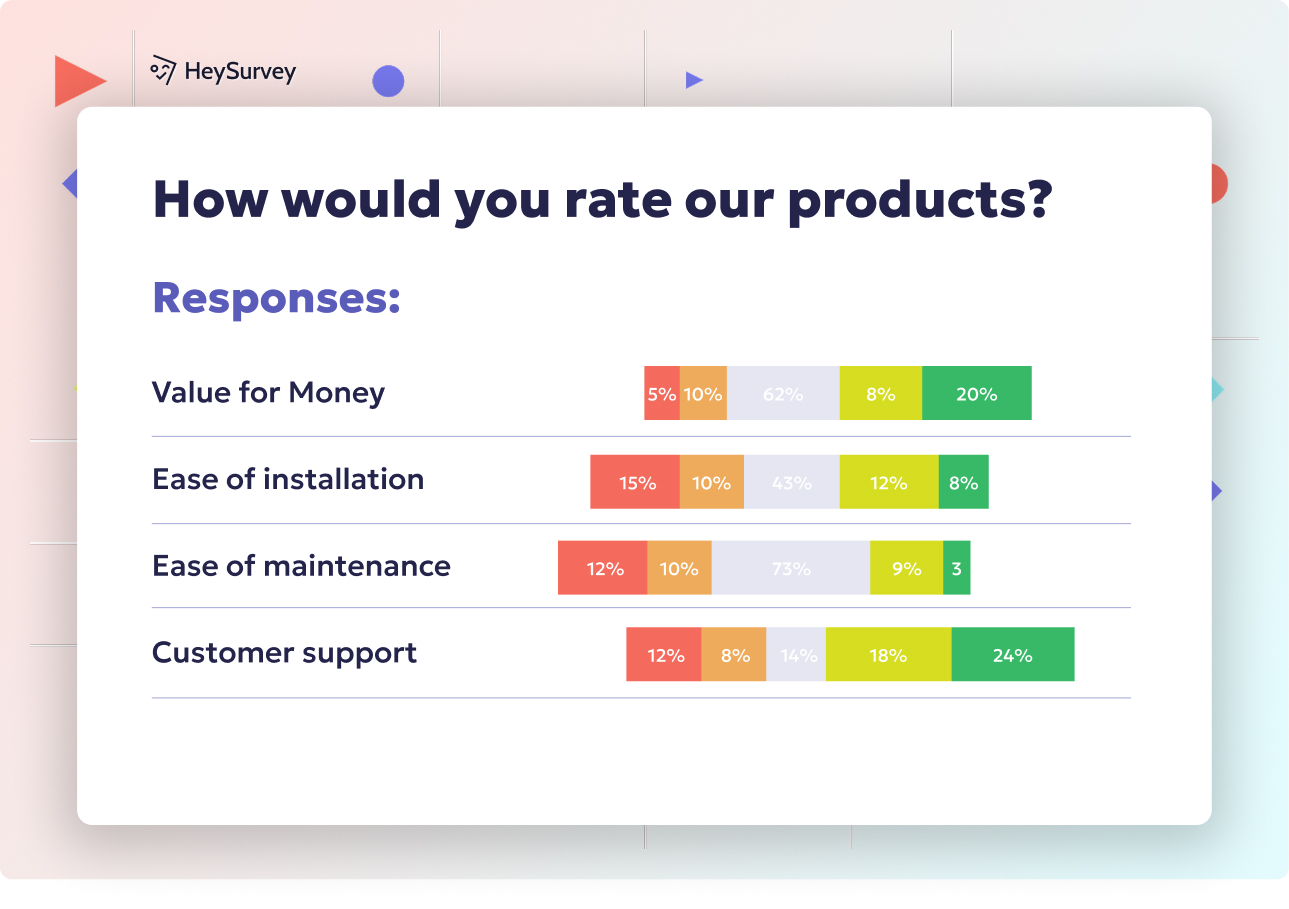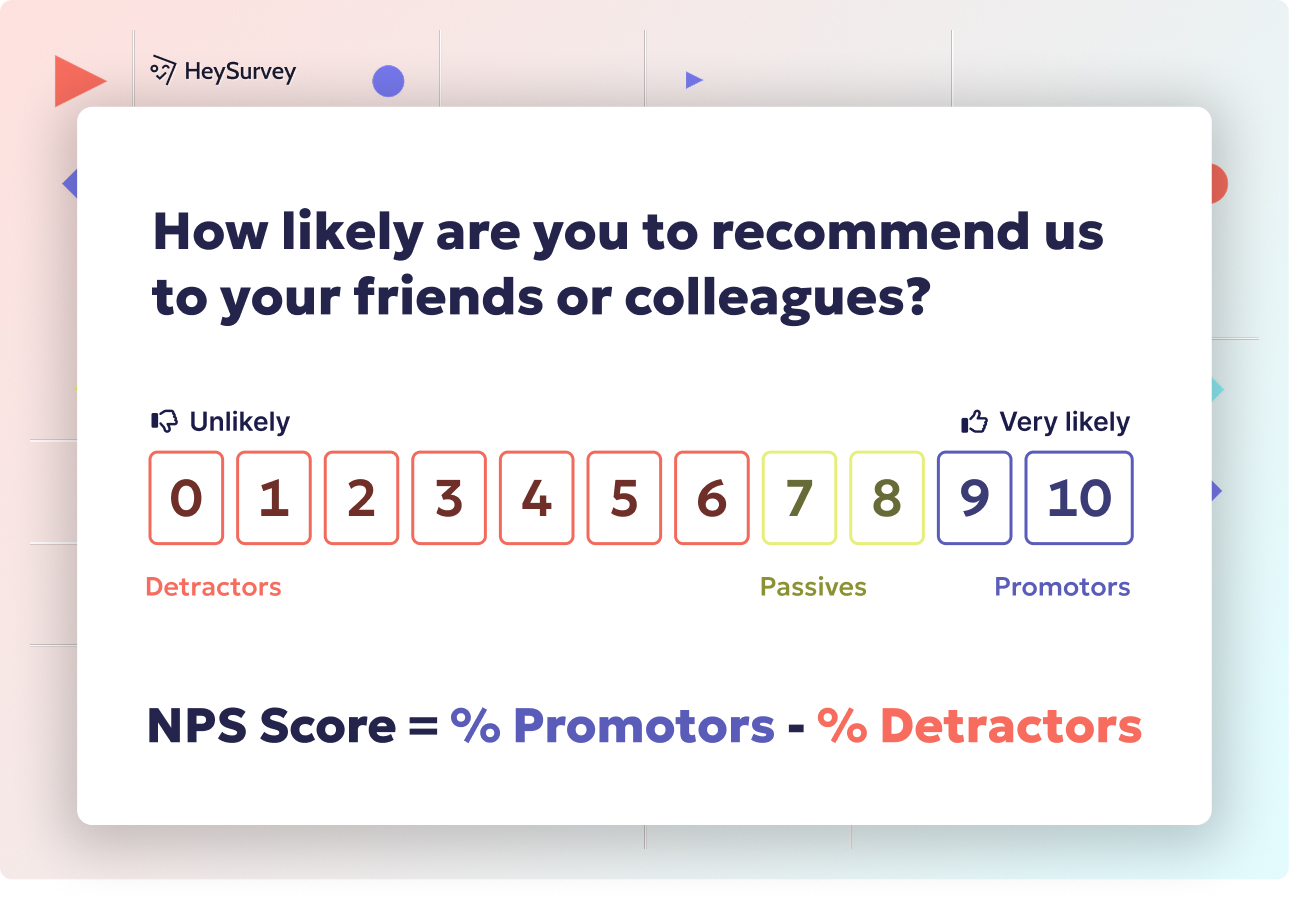29 Survey Questions for College Students: Top Types & When to Use
Discover 8 essential survey types with 25+ sample survey questions for college students to enhance academics, campus life, and student feedback.
Surveying college students is like opening a window into their world—one that’s brimming with unique ideas, hidden struggles, and campus dreams. Student feedback helps shape better academics, fuels higher retention, and transforms campus life from cafeteria food to club events. Every stage in the college journey—orientation, midterms, finals, you name it—calls for a special kind of student survey. From big-picture campus surveys to nitty-gritty higher-ed questionnaires, it’s all about asking the right questions at the right time.
Academic Experience Surveys
Why Academic Surveys Matter
Picture a classroom where lectures are riveting, study materials actually help, and office hours feel inviting. That’s not just wishful thinking—it’s what effective academic surveys strive to create. By gathering course feedback at the end of each semester or during curriculum reviews, you can spot trends, address pain points, and nudge programs toward excellence.
Institutions depend on academic survey insights for teaching evaluation and accreditation. When colleges ask the right questions, faculty get fuel for development workshops and students see their suggestions come to life in revamped syllabi. This isn’t just about rating a professor’s choice in neckties; it’s about designing curricula that connect and stick!
What Academic Surveys Cover
A truly impactful academic survey dives into:
- Relevance of course content to real-life goals.
- Teaching effectiveness across different styles.
- Workload balance—not all-nighters, all the time!
- Learning resources—from online notes to chemistry labs.
When to Use These Surveys
Deploy these college student survey questions:
- At the end of every course.
- During department-wide curriculum reviews.
- As part of accreditation requirements.
- After new teaching strategies are tried out.
Sample Questions
How effectively did the course materials help you meet the learning objectives?
Which instructional methods (lectures, group work, labs) enhanced your understanding most?
How manageable was the weekly workload for this course?
Rate the accessibility of tutoring or professor office hours.
What is one change that would most improve this course?
Course feedback transforms classrooms into more engaging, balanced, and resourceful places. Every response lays the groundwork for better learning.
The National Survey of Student Engagement (NSSE) assesses student participation in educational activities, aiding institutions in enhancing teaching practices and student engagement. (en.wikipedia.org)

Creating a survey with HeySurvey is as easy as pie. Follow these 3 simple steps to get your college student survey questions out to the world (or at least your campus):
Step 1: Create a New Survey
Start by logging into HeySurvey or jump right in without an account (you can publish later when signed up). Click “Create New Survey” and choose either:
- An empty survey to build from scratch, or
- A pre-built template for a quick start tailored to your survey type.
Give your survey an internal name that helps you spot it later—something like “Student Life & Engagement Q2-2024” works nicely.
Step 2: Add Your Questions
Click the “Add Question” button to start building. Pick question types that fit your needs:
- Multiple choice for easy campus involvement questions.
- Scale questions for rating mental health or academic satisfaction.
- Text answers for detailed feedback and suggestions.
Enter your question text (bold it for emphasis!), add descriptions if needed, and mark important questions as required so no one skips the essentials. Toss in images or gifs to keep respondents on their toes.
Don’t forget to explore the branching feature if you want paths that adjust based on responses—ask about internships, then dive deeper only if a student says “Yes.”
Step 3: Preview and Publish
Once your survey looks good, hit Preview to see it through your respondents’ eyes. Make sure it shines on mobiles and desktops alike (thanks, responsive design!).
Satisfied? Click Publish and grab your shareable link. Post it in emails, on the LMS, or display QR codes around campus for easy access.
Bonus Step 1: Apply Your Branding
Make this survey unmistakably yours by adding your school logo and customizing colors through the Designer Sidebar. Pick fonts and backgrounds that scream “campus pride.”
Bonus Step 2: Define Settings
Tweak your survey’s start/end dates, set response limits if you want to keep it exclusive, or add a custom thank-you redirect URL. Decide if responders can peek at summary results after submitting.
Bonus Step 3: Use Branching to Personalize
Use branching logic so students only see questions relevant to them. For example, if a student hasn’t used counseling services, skip those questions entirely. This keeps surveys concise and feels less like a chore.
Ready to launch? Just click the button below to open a pre-built survey template and start customizing. Your next batch of valuable student feedback is just a few clicks away!
Student Life & Engagement Surveys
The Magic of Engagement
Campus isn’t just about cramming for exams! Whether it’s a quirky improv club, a legendary game night, or late-night chats at student government, student engagement surveys measure how connected students feel. A vibrant campus life isn’t automatic—it’s handcrafted by hearing what truly pulls students out of their rooms.
Why and When to Survey Engagement
By launching campus involvement questions mid-semester or after major events, schools can:
- Reveal what inspires students to join activities.
- Pinpoint where campus feels inclusive, and where it lags.
- Power up event planning cycles with real data.
Run these pulse checks:
- A few weeks into each semester.
- After large campus events.
- During student government initiatives.
What Engagement Surveys Should Cover
A winning engagement survey goes deep on:
- Participation in extracurriculars—from chess club to quidditch.
- Sense of belonging—does campus feel like a home?
- Barriers to involvement—money, time, or just “meh”?
Sample Questions
How often do you attend campus-sponsored events?
Which clubs or organizations are most valuable to you and why?
Do you feel a strong sense of community at this institution?
What barriers prevent you from engaging in student life?
Which new activities would you like to see added next semester?
Student engagement surveys light the path to a more connected, buzzing campus. After all, college isn’t just what happens in the classroom—it’s everything in between.
Active learning techniques in university courses reduce failure rates from 32% to 21% and increase student performance by 0.47 standard deviations. (en.wikipedia.org)
Mental Health & Well-Being Surveys
The Pulse of Student Well-Being
Midterms, finals, group projects, roommate drama—sound familiar? It’s no secret that college can be stressful, and a college mental health survey is essential for cutting through the stigma and helping students thrive, not just survive. Assessing mental health is about more than numbers: it sparks real conversations.
Why and When to Send Well-Being Surveys
By timing well-being or student wellness questionnaires during high-stress periods, campuses can:
- Spot trends in student stress before burnout hits.
- Get feedback after mental health campaigns.
- Plan counseling resources more efficiently.
Deploy these gems:
- In the run-up to midterms and finals.
- After orientation or major wellness campaigns.
- Routinely to check the campus climate.
What Mental Health Surveys Should Address
Key topics for effective wellness surveys:
- Stress levels (and what triggers them).
- Awareness and ease of accessing counseling.
- Comfort level seeking support for emotional issues.
- Campus culture around stigma (“Therapy? Yikes or yes, please?”).
Sample Questions
On a scale of 1-10, how would you rate your current stress level?
Are you aware of on-campus mental health services?
How comfortable do you feel seeking help for emotional concerns?
Which campus factors contribute most to your stress?
What additional well-being resources would you find helpful?
Student wellness questionnaires open the door to real support, smarter resource planning, and a campus culture with less stress and more support. Surveys like these don’t just crunch numbers—they help students feel seen.
Career Preparedness Surveys
Bridging the Classroom and Career
Why do students juggle endless assignments and caffeine-fueled nights? The payoff is that dream job—or at least a job that pays the rent! Career readiness surveys ensure students make the leap from classroom theory to real-world skills without a faceplant.
Why and When to Deploy Career Surveys
Using internship feedback questions in upperclassman years or after big career fairs helps colleges:
- Gauge job-search confidence and skill gaps.
- Tune up career center resources and workshops.
- Build more powerful employer partnerships.
Drop these surveys:
- During junior and senior years.
- After students attend career fairs or employer events.
- When conducting pre-graduation audits.
What to Cover in Career Surveys
Stack career preparedness surveys with:
- Access to internships and co-ops.
- Quality of career center guidance.
- Preparedness in professional skills (resumes, interviews, LinkedIn mastery).
- Networking with recruiters and industries students care about.
Sample Questions
How confident are you in your job-search skills (resume writing, interviewing)?
Rate the usefulness of the career center’s services.
Have you completed at least one internship or co-op?
Which professional skills do you feel least prepared in?
Which industries or employers would you like more campus partnerships with?
Internship feedback questions are treasure maps, pointing to the experiences and resources students actually want as they prepare for life after graduation.
Only 41% of U.S. college students feel "very" or "extremely" prepared for their future careers. (mheducation.mediaroom.com)
Diversity, Equity & Inclusion (DEI) Surveys
Fostering an Inclusive Campus
Every campus dreams of being a place where everyone—no matter their background—can thrive. With regular campus climate surveys, colleges can address simmering concerns before they boil over. Asking DEI questions for students means giving a voice to those whose stories might go unheard.
Why and When to Run DEI Surveys
Annual DEI surveys or spot checks after major campus events make a powerful impact. These surveys:
- Surface honest feedback after DEI trainings.
- Document and address discrimination incidents.
- Guide the next round of inclusion initiatives.
Launch after:
- Notable campus incidents.
- New DEI policies or training sessions.
- At least every academic year.
What Should DEI Surveys Measure?
The best DEI surveys drill into:
- Respect and inclusion, regardless of identity.
- Courses and campus life reflecting cultural diversity.
- Effectiveness of DEI initiatives—are they just buzzwords, or is something changing?
- Incidents of discrimination (real talk only).
Sample Questions
Do you feel respected and included regardless of your background?
Have you witnessed or experienced discrimination on campus this year?
How culturally responsive are your course materials?
Rate the effectiveness of recent DEI initiatives.
What actions should the university take to foster greater inclusion?
DEI questions for students move campuses closer to a culture where everyone belongs, and no one is left behind in the margin.
Campus Services & Facilities Surveys
Measuring the Heartbeat of Campus Services
A leaky faucet, Wi-Fi as slow as dial-up, or bland dining hall food—little things can make or break the student experience. By sending out campus facilities surveys and collecting student services feedback, colleges don’t need to guess where to invest next.
Why and When to Survey Campus Services
Facilities surveys are a perfect fit:
- At the end of the academic year, when the semester’s struggles are fresh.
- After rolling out major facility upgrades (hello, shiny new gym!).
- During budgeting cycles, when deciding what to fix or upgrade first.
What Should Facility Surveys Target?
To really see which services work, include:
- Housing quality and dorm amenities.
- Dining halls and nutritional variety (is it all pizza, all the time?).
- Library and study space access.
- Campus Wi-Fi reliability.
- Sports and recreation facilities.
Sample Questions
How satisfied are you with on-campus housing quality?
Rate the nutritional variety of dining hall menus.
Are study spaces available when you need them?
How reliable is campus Wi-Fi in academic buildings?
Which facility improvements should be prioritized next year?
Campus facilities surveys tell campus leaders what works, what fails, and what’s next. Sometimes that fix is just a survey away.
Online Learning Experience Surveys
Making Remote Learning Better for All
Online courses have gone from a nice-to-have option to a must-survive reality (thank you, global disruptions!). With online course surveys and targeted virtual learning feedback, schools can check where the tech lags and the magic happens.
Why and When to Survey Online Learners
Whenever a campus offers hybrid or all-virtual learning (planned or “surprise, it’s a pandemic!”), these surveys help by:
- Evaluating video, quiz, and peer-discussion experiences.
- Catching tech issues that trip up students.
- Powering improvements in online engagement.
Deploy after:
- Hybrid or remote class completion.
- Mid-semester, if major online tech updates roll out.
- After emergency remote transitions.
What to Measure in Online Surveys
Key topics for online learning feedback:
- Interface usability—is the online platform a friend or foe?
- Peer engagement during virtual discussions.
- Assessment fairness—do remote tests align with what’s taught?
- Tech support satisfaction—are problems fixed fast?
Sample Questions
How intuitive is the learning management system interface?
Did virtual discussions foster meaningful interaction with peers?
Were online assessments aligned with course objectives?
How adequate was technical support for resolving issues?
What improvements would enhance your remote learning experience?
Virtual learning feedback highlights the upgrades that can take online classes from “meh” to magnificent. Every click, every submission, improves the next course.
Best Practices: Dos and Don’ts for College Student Surveys
Dos for Supercharged Surveys
Making your survey sparkle isn’t rocket science, but it does take some care. Follow these dos for higher response rates and honest answers:
- Use clear language—skip the academic jargon, and say it straight.
- Limit survey length—longer surveys mean more yawns and fewer completions.
- Ensure anonymity for all responses, especially for sensitive topics.
- Offer incentives—a gift card or campus swag can work wonders.
- Close the feedback loop—share survey results and what’s changing as a result.
Don’ts: Oops-Proof Your Surveys
No one wants a survey that irritates or alienates students. Avoid these pitfalls:
- Don’t use leading or loaded questions that nudge for certain answers.
- Don’t force sensitive disclosures—give “prefer not to say” as an out.
- Don’t ignore mobile optimization—if it looks weird on a phone, students will bounce.
- Don’t send surveys during finals without warning—timing is everything!
Make Distribution Effortless
Getting surveys into student hands (and devices) is crucial:
- Send via email blasts with catchy subject lines.
- Use learning management system (LMS) pop-ups for quick responses.
- Place QR codes around campus—cafeterias, residence halls, libraries.
Response Rate and Data Ethics
A few extra tricks for response success and ethical handling:
- Send gentle reminders, but don’t bombard inboxes endlessly.
- Design with “mobile-first” in mind—tap, tap, done!
- Always store feedback securely and make privacy policies clear.
High-impact campus surveys unlock the secrets to better classes, happier students, and a campus that’s ready for whatever comes next. Each survey type is a key, opening up spaces for learning, growth, and belonging. So, keep asking, keep listening, and watch your college community thrive.
Related Student Survey Surveys

31 Survey Questions Examples for Students to Improve Learning
Discover 28 survey questions examples for students across 6 key types to boost engagement, feedba...

29 Class Survey Questions: Proven Templates for Every Stage
Discover 40+ proven class survey questions with detailed templates for every course stage to boos...

30 Survey Questions for Students: 6 Types & When to Use Them
Explore 6 powerful survey types with 30+ sample survey questions for students to boost engagement...
